ISSN ONLINE(2278-8875) PRINT (2320-3765)
ISSN ONLINE(2278-8875) PRINT (2320-3765)
Kalpana Chikatwar1, Boya Satyanarayana2, Dr. S. N. Mulgi3
|
| Related article at Pubmed, Scholar Google |
Visit for more related articles at International Journal of Advanced Research in Electrical, Electronics and Instrumentation Engineering
This paper presents the design and development of simple rectangular monopole microstrip antenna (RMA) for wideband operation. The proposed antenna operates from 1.54 to 4.62GHz and gives an impedance bandwidth of 100% which is 32.46 times more than the impedance bandwidth of conventional rectangular microstrip antenna (CRMA). The RMAhas been realized from CRMA by modifying the microstripline feed of CRMA which further simplifies the geometry of RMA. The peak gain of RMAin its operating band is found to be 7.08 dB which is 3.35 times more than the peak gain of CRMA. The antenna characteristics such as return loss, radiation pattern etc. are discussed in this paper. This antenna may find the applications for WLAN and WiMAX.
Keywords |
| Rectangular monopole antenna, Wideband, 50Ω microstripline feed, WLAN, WiMAX. |
INTRODUCTION |
| In many modern wireless applications where physical size, weight, cost, performance of the device, ease of installation, simple structure and aerodynamic profile are required [1]. The low profile antennas like microstrip antennas (MSAs) are the best choice. However, MSAs inherently have narrow impedance bandwidth (BW) and low gain [2]. Many researchers have made efforts continuously to overcome the demerits of narrow impedance bandwidth. Various techniques such as use of different geometries, slot loading, use of different feeding techniques etc. have been presented [3-7] to improve the antenna performances. |
| In recent years the monopole antennas are finding increasing application because of their significant merits like wide impedance bandwidth, compactness, simple structure, low interference to other systems, omnidirectional radiation pattern, ease of fabrication etc. The monopole antennas have been designed and developed using regular shaped configurations such as circular, elliptical, triangular etc. with additional elements associated with the main element makes antenna structure complex in nature. Simple geometries such as square and rectangular monopole antennas were also designed, but they give comparatively less impedance bandwidth [8].In this paper, a simple geometry low-cost rectangular monopole antenna is derived from the CRMA by replacing quarter wave transformer and microstripline feed with a single microstripline feed and a continuous copper plane which is placed below the microstripline feed on the bottom layer of the substrate. This novel design is found to be simple in the antenna geometry and operates for wide frequency ranges with enhanced gain. |
ANTENNA DESIGNING |
| The top view geometry of CRMA is as shown in Fig. 1. This CRMA consists of a radiating patch of width „WâÃâ¬ÃŸ and length „LâÃâ¬ÃŸ, The antenna is excited through a simple 50Ω microstripline feeding with length Lf =2.18 cm and Wf= 0.32 cm. The quarter wave length matching transformer having length Ltr= 1.09 cm and Wtr = 0.06 cm is used to match the impedance between the feed point along the width of the radiating rectangular patch with 50Ω microstripline feed. Below the substrate a tight copper shielding is used as a ground plane. At the tip of the microstripline feed a microwave power source is assigned.The CRMA antenna is designed for the resonant frequency of 3.5 GHz using the formulae available in the literature for the design of rectangular microstrip antenna. A low cost glass epoxy substrate material of area X × Y with thickness h= 0.16 cm and a relative permittivity of 4.2 is used. The simulation performances are done by using commercial Ansoft HFSS software package. |
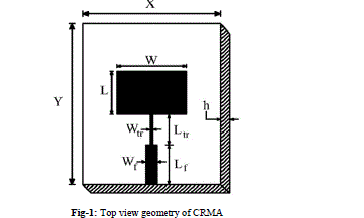 |
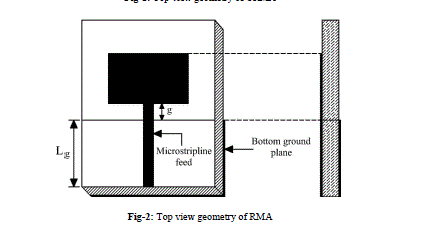 |
| Figure 2 shows the top view geometry of proposed RMA which is realized from CRMA by using a single 50Ω microstripline feed of length (Lg+g) = 2.77cm. This length of feed line is 28.8% shorter than the length (Lf+ Ltr) of microstripline used for CRMA as shown in Fig. 1 which makes RMA compact in its size and simplifies the design structure. The microstripline of RMA is connected at the centre along the width of the rectangular patch. A continuous copper ground plane of heightLg = 2.5cm is placed below the microstripline feed on the bottom layer of the substrate.The distance between the radiating patch and the partial ground plane is g = 0.27 cm. The proposed RMA is dependent on the two important parameters such as height of partial ground plane Lgand feed distance „gâÃâ¬ÃŸ. By controlling these parameters performance of RMA may be improved. The design parameters of the proposed antennas are given in Table-1. |
RESULT AND DISCUSSIONS |
| The variation of return loss versus frequency of CRMA is as shown in Fig. 3. From this figure, it is clear that, the impedance bandwidth over return loss less than -10 dB simulated using commercial electromagnetic simulation software Ansoft HFSS, the CRMA resonates at 3.25 GHz of frequency which is close to the design frequency of 3.5 GHzwhich justifies the design of CRMA. From Fig. 3, the impedance bandwidth is calculated using the equation, |
| where, fL and fH are the lower and upper cut of frequencies of the band, respectively, when its return loss reaches -10 dB and fcis the centre frequency betweenfH and fL.The impedance bandwidth of CRMA is found to be BW1 = 3.08%. |
 |
| When CRMA is modified as RMA, the antenna operates from 1.54 GHz to 4.62 GHz. This means that, the antenna operates for a wide band of frequencies BW2 which is quite large compared to the operating band of BW1. The magnitude of impedance bandwidths BW2 is found to be 100%. Hence 3.08% of impedance bandwidth of CRMA has been enhanced to 100 % by constructing RMA. Further from Fig. 4 it is clear that, the lower cut off frequency of RMA is 1.54 GHz. By comparing the lower cut off frequency of CRMA shown in Fig. 3 which is at 3.20 GHz,the RMA also shows the property of virtual size reduction which is 51.87%. The peak gain of CRMA and RMA are measured in their operating bands BW1 and BW2, are found to be 2.10 dB and 7.08 dBrespectively. Hence by constructing RMA gain can be enhanced by 3.35 times more than the peak gain of CRMA. |
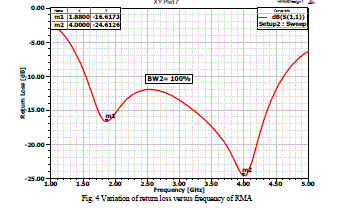 |
| The typical co-polar and cross-polar radiation pattern of RMA is measured in its operating band i.e. at 1.88 GHz (m1) and 4 GHz (m2) which are shown in Fig. 5(a)-5(b) respectively. From Fig. 5 it is clear that, the patternsarenearly omnidirectional in nature. |
| Figure 6(a) and 6(b) shows the top and ground plane surface current distributions of RMA which are observed at the typical frequencies of 1.88 GHz and 4 GHz respectively. Fromthese figures it is seen that, the current distribution towards the edge point of the microstriplinefeed on top surface and uniform current distribution is observed at the ground plane surface of the antenna causing wideband operation. |
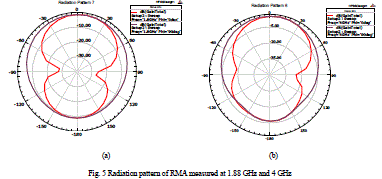 |
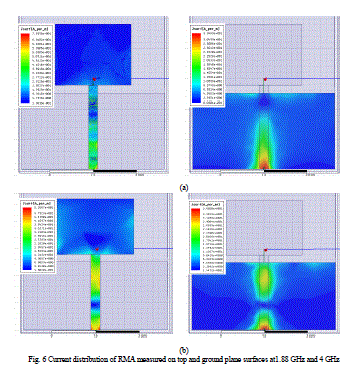 |
CONCLUSION |
| A simple low cost RMA has been designed for wideband operation. The proposed RMA has been constructed from CRMA by replacing quarter wave transformer and microstripline feed with a single reduced microstripline feed which further simplifies the geometry of the antenna. A continuous copper ground plane of height Lg is placed below the microstripline feed on the bottom layer of the substrate. The RMA is simple and compact in its design compare to the size of CRMA. The impedance bandwidth of CRMA is enhanced from 3.08% to 100% and gain from 2.10 dB to 7.08dB by the construction of RMA. The RMA also shows the property of virtual size reduction of 51.87%. The two parameters such as Lg and „gâÃâ¬ÃŸ may be varied for further investigations to improve the performance of antenna. The proposed antenna may find application for WLAN and WiMAX. |
References |
|